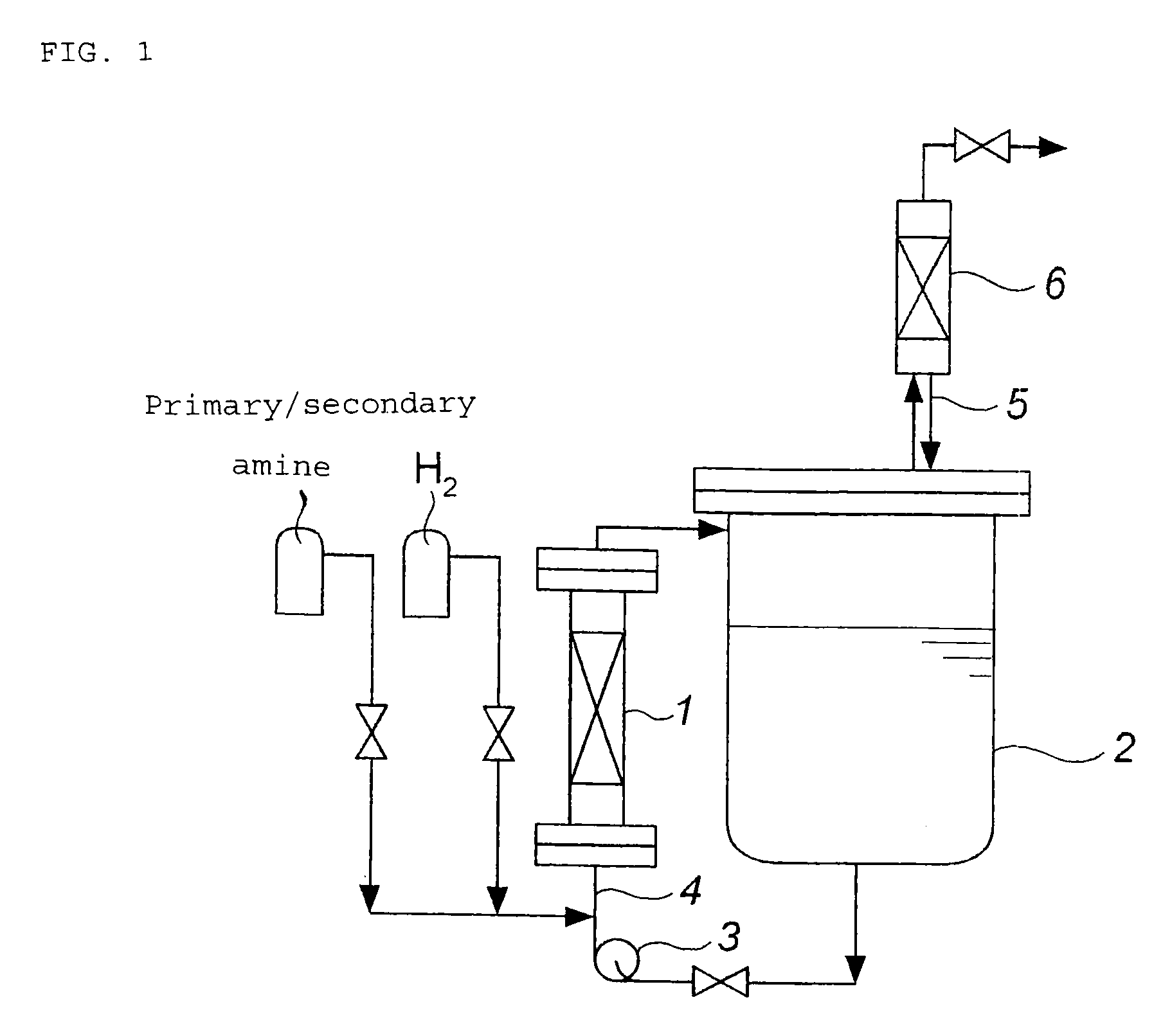Process for production of tertiary amines
a technology of tertiary amine and amine, which is applied in the preparation of amino compounds, physical/chemical process catalysts, metal/metal-oxides/metal-hydroxide catalysts, etc., can solve the problems of complex facilities and operations, increased waste material, and inability to apply systems
- Summary
- Abstract
- Description
- Claims
- Application Information
AI Technical Summary
Benefits of technology
Problems solved by technology
Method used
Image
Examples
production example 1
Production of Film Type Catalyst A
[0036]A film type catalyst A in which a powdery catalyst was fixed using phenol resin as a binder was prepared as follows.
[0037]A flask having a volume of one litter was charged with synthetic zeolite and then with a solution prepared by dissolving copper nitrate, nickel nitrate and ruthenium chloride in water such that Cu:Ni:Ru=4:1:0.01 in the molar ratio of metal atoms, and then the mixture was heated under stirring. At 90° C., an aqueous 10% sodium carbonate solution was gradually dropped into it while the pH was controlled at 9 to 10. After 1-hour aging, precipitates were filtered off, washed with water, then dried at 80° C. for 10 hours and calcined at 600° C. for 3 hours to give a powdery catalyst. The obtained powdery catalyst contained the metal oxides at a ratio of 50% by weight and the synthetic zeolite at a ratio of 50 by weight.
[0038]To 100 parts by weight of the powdery catalyst described above, phenol resin (PR-9480, manufactured by Su...
production example 2
Production of Film Type Catalyst B
[0039]A film type catalyst B in which a powdery catalyst was fixed using phenol resin as a binder was prepared as follows.
[0040]Phenol resin (PR-9480 with 58% non-volatiles, manufactured by Sumitomo Bakelite Co., Ltd.) was added as a binder to 100 parts by weight of the powdery catalyst prepared according to Production Example 1, such that the content of non-volatiles in the phenol resin became 47.7 parts by weight. Then, 4-methyl-2-pentanone was added as solvent thereto such that the solids content (the powdery catalyst and non-volatiles in the phenol resin) became 55%. The mixture was preliminarily mixed by a Disper for 10 minutes, then mixed and dispersed at 1500 rpm for 70 minutes in a basket mill (SS-3 manufactured by ASADA IRON WORKS, Co., Ltd., charged with 800 mL (1900 g) titania beads of 1.4 mm in diameter) to form a coating. A copper foil (thickness 40 μm, 0.3 m×36 cm) was used as a support, and the coating was applied by a gravure coater ...
production example 3
Production of Film Type Catalyst C
[0041]A film type catalyst C in which a powdery catalyst was fixed using phenol resin as a binder was prepared as follows.
[0042]To 100 parts by weight of the powdery catalyst produced according to Production Example 1, phenol resin (PR-9480, manufactured by Sumitomo Bakelite Co., Ltd., nonvolatile content: 58%) was added as a binder such that the nonvolatile content of the phenol resin became 33.3 parts by weight. Then, 4-methyl-2-pentanone was added as solvent thereto such that solids content (the powdery catalyst and non-volatiles in the phenol resin) became 55%. The mixture was preliminarily mixed by a Disper for 10 minutes, then mixed and dispersed at 1500 rpm for 70 minutes in a basket mill (SS-3 manufactured by ASADA IRON WORKS Co., Ltd., charged with 1900 g (800 mL) titania beads having a diameter of 1.4 mm,) to form a coating. A copper foil (thickness 40 μm, 6.5 cm×420 cm×1 sheet) was used as a support, and the coating was applied by a bar c...
PUM
| Property | Measurement | Unit |
|---|---|---|
| thickness | aaaaa | aaaaa |
| thickness | aaaaa | aaaaa |
| distance | aaaaa | aaaaa |
Abstract
Description
Claims
Application Information
 Login to View More
Login to View More - R&D
- Intellectual Property
- Life Sciences
- Materials
- Tech Scout
- Unparalleled Data Quality
- Higher Quality Content
- 60% Fewer Hallucinations
Browse by: Latest US Patents, China's latest patents, Technical Efficacy Thesaurus, Application Domain, Technology Topic, Popular Technical Reports.
© 2025 PatSnap. All rights reserved.Legal|Privacy policy|Modern Slavery Act Transparency Statement|Sitemap|About US| Contact US: help@patsnap.com

